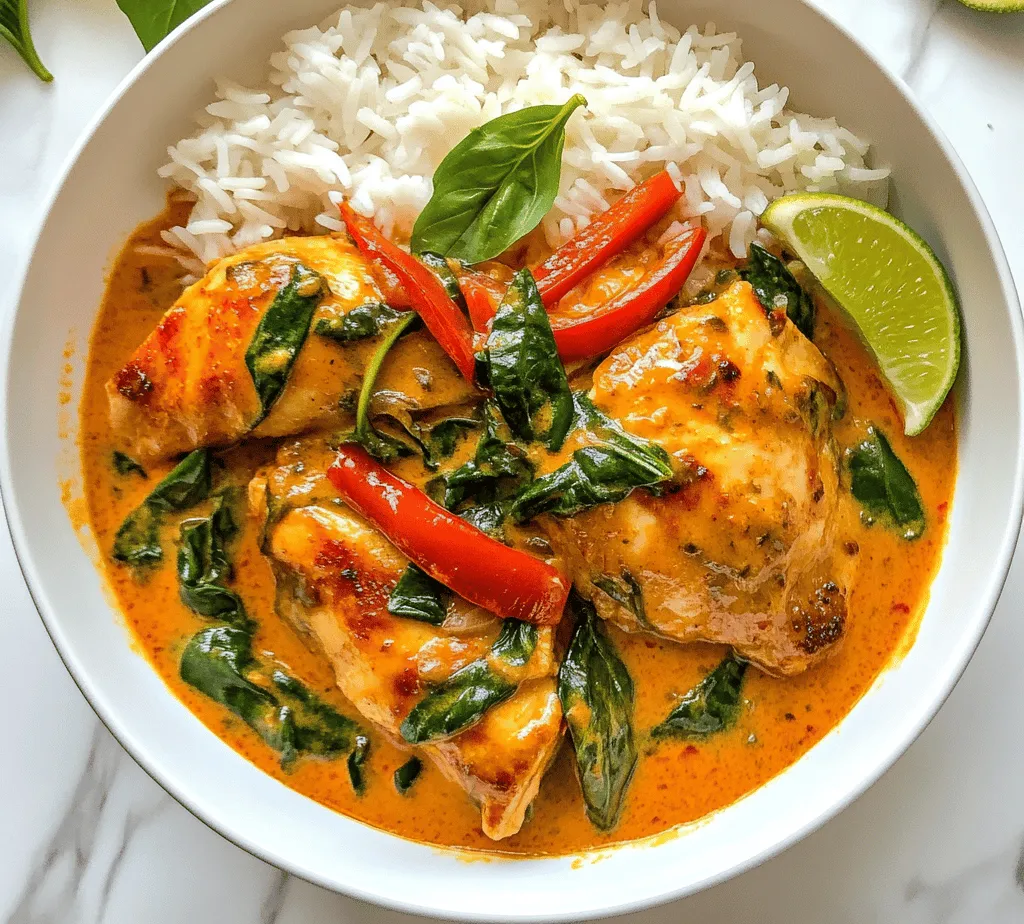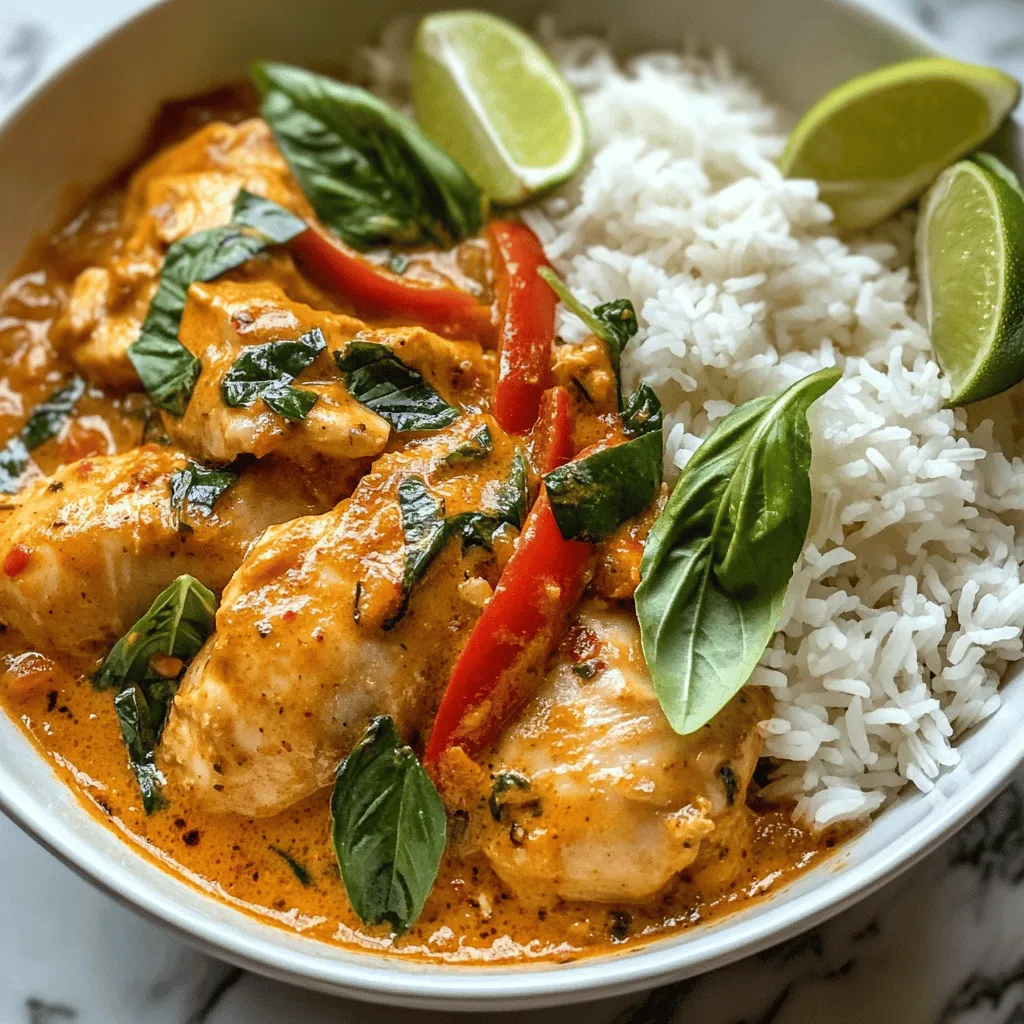Introduction
Thai cuisine is renowned for its vibrant flavors and harmonious balance of sweet, sour, salty, and spicy elements. Each dish tells a story, reflecting the rich culture and traditions of Thailand. Among the many delightful offerings, Spicy Thai Red Curry Chicken stands out as a comforting and satisfying meal that warms the soul. This dish encapsulates the essence of Thai cooking, showcasing the art of blending fresh ingredients with aromatic spices to create a symphony of flavors that tantalize the palate.
The hallmark of a great Thai red curry lies in its authenticity. Utilizing fresh ingredients and traditional spices enhances the dish’s depth and complexity, making it an experience that goes beyond mere sustenance. Whether enjoyed on a cozy evening or served at a gathering, Spicy Thai Red Curry Chicken offers a taste of Thailand that is both approachable and indulgent.
Understanding the Key Ingredients
To create an outstanding Spicy Thai Red Curry Chicken, understanding the key ingredients is essential. Each component plays a critical role in constructing the dish’s flavor profile, texture, and overall appeal.
Boneless, Skinless Chicken Thighs
The foundation of this dish is boneless, skinless chicken thighs. Unlike chicken breasts, thighs offer a richer flavor and remain juicy and tender during cooking. They are perfect for absorbing the aromatic spices and curry sauce, ensuring every bite is bursting with flavor. Additionally, thighs are more forgiving when it comes to cooking time, reducing the risk of drying out the meat.
Red Curry Paste
At the heart of any Thai curry is the curry paste, and red curry paste is a crucial element in this recipe. This vibrant mixture is typically made from red chilies, garlic, lemongrass, shallots, galangal, and a variety of spices. The combination provides a complex flavor profile, balancing heat with fragrant undertones. The paste is what gives the curry its signature color and kick, making it a vital ingredient that should not be overlooked.
Coconut Milk
Coconut milk is another essential component of Spicy Thai Red Curry Chicken. It adds a creamy texture that counteracts the spiciness of the red curry paste, creating a luscious sauce that envelops the chicken. The natural sweetness of coconut milk also enhances the overall flavor, making each spoonful delightful. When selecting coconut milk, look for high-quality brands that come in a can, as they tend to have a richer flavor and better consistency than those in cartons.
Chicken Broth
Chicken broth serves to deepen the flavors of the curry while providing the right consistency. It complements the coconut milk and allows the spices to meld together beautifully. Using homemade or low-sodium store-bought chicken broth can elevate the dish, ensuring that you maintain control over the saltiness and flavor intensity.
Fish Sauce and Brown Sugar
Fish sauce is a quintessential ingredient in Thai cooking, providing umami and depth to the curry. It is made from fermented fish and adds a savory saltiness that enhances the overall taste. When incorporated into the recipe, fish sauce elevates the flavors, making them more vibrant.
Brown sugar, on the other hand, introduces a touch of sweetness that balances the heat from the red curry paste and the saltiness from the fish sauce. This sweet-savory combination is a signature characteristic of Thai cuisine, allowing each flavor to shine while working in harmony with the others.
Bell Peppers and Spinach
To round out the dish, bell peppers and spinach add both color and nutritional benefits. Bell peppers, available in various colors, contribute a subtle sweetness and crunch that contrasts beautifully with the tender chicken and creamy sauce. Spinach, with its mild flavor, enriches the dish with vitamins and minerals, providing a healthy boost. Together, these vegetables not only enhance the visual appeal but also contribute to a well-rounded meal.
Preparing for Success: Essential Tools and Equipment
Before diving into the cooking process, having the right tools and equipment can make all the difference in achieving the perfect Spicy Thai Red Curry Chicken. Here’s a list of recommended kitchen tools to ensure your cooking experience is smooth and enjoyable.
Large Skillet or Wok
A large skillet or wok is essential for making Thai red curry chicken. The wide surface area allows for even cooking and ensures that the chicken browns nicely. Additionally, it provides ample space for sautéing the aromatics and incorporating the vegetables without crowding the pan.
Rice Cooker or Pot
Perfectly cooked jasmine rice is the ideal accompaniment to this dish. A rice cooker simplifies the process, allowing you to focus on the curry while the rice steams to fluffy perfection. If you don’t have a rice cooker, a pot on the stovetop will work just as well—just ensure you monitor the cooking time for the best results.
Knife and Cutting Board
Sharp knives and a sturdy cutting board are vital for efficiently chopping the ingredients. A good chef’s knife will make quick work of slicing the chicken, bell peppers, and any other aromatics you’ll need.
Measuring Cups and Spoons
Accurate measurements are key to achieving the right balance of flavors, particularly when working with spices and sauces. Having a set of measuring cups and spoons on hand ensures that you can easily follow the recipe and adjust to your taste.
Step-by-Step Cooking Instructions
Now that you’re familiar with the key ingredients and essential tools, it’s time to dive into the cooking process. Let’s start with preparing the jasmine rice, which is a straightforward yet crucial element of the meal.
Cooking Jasmine Rice
1. Measure the Rice: Start by measuring out 1 cup of jasmine rice. This amount typically serves 2-3 people, but you can adjust it based on your needs.
2. Rinse the Rice: Rinse the rice under cold water until the water runs clear. This step removes excess starch and helps prevent the rice from becoming gummy.
3. Cook the Rice:
- Using a Rice Cooker: Add the rinsed rice and 1 ¾ cups of water to the rice cooker. Turn it on and let it cook according to the manufacturer’s instructions.
- Stovetop Method: In a pot, combine the rinsed rice and 1 ¾ cups of water. Bring it to a boil, then reduce the heat to low, cover, and simmer for about 15-20 minutes until the water is absorbed. Remove from heat and let it sit covered for an additional 5 minutes before fluffing with a fork.
Sautéing Aromatics
While the rice is cooking, it’s time to prepare the base for your curry. Aromatics play a pivotal role in building flavor, and garlic and ginger are essential in this dish.
1. Prepare the Aromatics:
- Mince 2-3 cloves of garlic and a small piece (about 1 inch) of fresh ginger. The combination of these two will create a fragrant foundation for the curry.
2. Heat the Skillet or Wok: Place your large skillet or wok over medium heat and add 1-2 tablespoons of vegetable oil. Allow the oil to heat until it shimmers.
3. Sauté the Aromatics: Add the minced garlic and ginger to the hot oil. Sauté for about 30 seconds until fragrant, being careful not to let them burn. The aroma will fill your kitchen, signaling the start of something delicious.
Browning Chicken Thighs
Now it’s time to add the star of the dish: the chicken thighs.
1. Cut the Chicken: If necessary, trim any excess fat from the boneless, skinless chicken thighs and cut them into bite-sized pieces. This ensures even cooking and allows the chicken to absorb the flavors of the curry sauce.
2. Brown the Chicken:
- Increase the heat to medium-high and add the chicken pieces to the skillet. Spread them out in a single layer to allow for proper browning.
- Cook for about 5-7 minutes, stirring occasionally, until the chicken is browned on all sides but not fully cooked through. This step adds depth of flavor and helps seal in the juices.
As you continue to prepare your Spicy Thai Red Curry Chicken, remember that each step contributes to the overall taste and enjoyment of the dish. The combination of fresh ingredients, authentic spices, and careful preparation will lead to a rewarding culinary experience that captures the spirit of Thai cuisine.

How to Incorporate Red Curry Paste for Maximum Flavor Extraction
To achieve the full flavor potential of Spicy Thai Red Curry Chicken, it is essential to understand how to use red curry paste effectively. The paste is a blend of aromatic spices, herbs, and seasonings that forms the backbone of the dish. The key to maximizing its flavor lies in sautéing it at the beginning of the cooking process.
1. Start with Oil: Begin by heating a tablespoon of coconut oil in your pan over medium heat. Coconut oil not only adds a subtle sweetness but also complements the rich flavors of the curry.
2. Sauté the Paste: Once the oil is hot, add 2-3 tablespoons of red curry paste, adjusting the amount according to your spice preference. Sauté the paste for 1-2 minutes until it becomes fragrant and the oil begins to separate. This step is crucial as it activates the essential oils in the spices, enhancing the overall flavor profile of the dish.
3. Add Aromatics: Incorporate minced garlic and ginger at this stage. Their pungent flavors will further enrich the curry. Sauté them for an additional minute until they soften.
Step-by-Step Method for Simmering the Curry and Achieving the Right Consistency
Now that your base is prepared, it’s time to build the curry. Here’s how to simmer the dish to perfection:
1. Add Chicken: Introduce your marinated chicken pieces to the pan. Stir them well to coat each piece in the fragrant paste. Cook for 5-7 minutes until the chicken is browned on the outside but not fully cooked.
2. Incorporate Coconut Milk: Pour in one can (about 400 ml) of coconut milk. The creaminess of coconut milk balances the heat of the curry and gives it a luscious texture. Stir gently to combine the chicken and paste with the coconut milk.
3. Simmer: Bring the mixture to a gentle simmer. Reduce the heat to low and cover the pan, allowing the chicken to cook through for about 15 minutes. This slow cooking method ensures that the chicken absorbs the flavors and remains tender.
4. Adjust Consistency: If the curry is too thick, add a splash of water or chicken broth to reach your desired consistency. For a richer taste, you can also add a tablespoon of fish sauce at this stage, enhancing the umami flavor without overpowering the dish.
Techniques for Introducing Vegetables at the Right Moment for Optimal Tenderness
Vegetables are an essential component of Spicy Thai Red Curry Chicken, providing color, texture, and nutritional benefits. Timing is everything when adding them to ensure they maintain their vibrant colors and crunch.
1. Choose Your Vegetables: Common additions include bell peppers, carrots, and zucchini. Each vegetable has a different cooking time, so it’s vital to add them at the right moment.
2. Timing the Addition: After the chicken has simmered for about 10 minutes, add vegetables that take longer to cook, such as carrots. After 5 minutes, add quicker-cooking vegetables like bell peppers and zucchini. This staggered approach ensures that all vegetables are cooked to perfection—tender but not mushy.
3. Final Simmer: Allow the curry to simmer for an additional 5-10 minutes until the vegetables are tender and the flavors meld together beautifully. You’ll know it’s ready when the chicken is fully cooked, and the vegetables are vibrant and crisp.
Final Touches: Garnishing with Fresh Basil and the Significance of Lime Wedges for Serving
Presentation can elevate your dish and enhance the dining experience. Here’s how to add those finishing touches:
1. Garnish with Basil: Just before serving, sprinkle freshly chopped Thai basil over the curry. The aromatic herb adds a burst of freshness and complements the spices beautifully.
2. Lime Wedges: Serve your curry with lime wedges on the side. The bright acidity of lime juice cuts through the richness of the coconut milk and enhances the overall flavor. Encourage your guests to squeeze fresh lime juice over their portion for an extra zing.
Flavor Profile and Taste Experience
Understanding the flavor profile of Spicy Thai Red Curry Chicken is essential to appreciate its complexity:
1. Balance of Flavors: The dish showcases a beautiful balance between spicy, sweet, and savory elements. The red curry paste brings heat from red chilies, while coconut milk adds creaminess and sweetness. This interplay creates a harmonious taste experience.
2. Ingredient Synergy: Each ingredient plays a vital role in complementing the others. For example, the chicken absorbs the rich flavors, while vegetables provide a fresh crunch. The fish sauce introduces a depth of umami, making each bite more satisfying.
3. Adjusting Spice Levels: One of the best aspects of this dish is its adaptability to suit your spice tolerance. To reduce heat, use less curry paste, or choose a milder variant. Conversely, for those who love a kick, additional chilies or a dash of chili oil can intensify the spice level without compromising the dish’s integrity.
Serving Suggestions and Pairings
When it comes to serving Spicy Thai Red Curry Chicken, there are numerous delightful options to elevate the meal:
1. Rice Options: Serve the curry over a bed of jasmine rice, which pairs beautifully with the flavors of the dish. Alternatively, try coconut rice for a sweeter, creamier option, or brown rice for added health benefits.
2. Side Dishes: Consider adding a simple cucumber salad to provide a refreshing contrast to the richness of the curry. Additionally, Thai spring rolls or steamed dumplings can serve as excellent appetizers.
3. Beverage Pairings: To complement the spice of the curry, serve it with a cold beer, such as a light lager or a fruity IPA. If you prefer non-alcoholic options, coconut water or a refreshing iced tea can balance the meal nicely.
4. Dessert Ideas: For dessert, traditional Thai mango sticky rice can provide a sweet ending to your culinary adventure. The creamy coconut milk used in the dessert mirrors flavors from the curry, making it a cohesive dining experience.
5. Cultural Context: In Thai culture, curry is frequently enjoyed as part of a communal meal, served family-style where everyone shares from the same pot. This practice fosters connection and enhances the enjoyment of the meal.
Nutritional Information
Being aware of the nutritional content of Spicy Thai Red Curry Chicken can help you make informed choices:
1. Nutritional Overview: A typical serving of Spicy Thai Red Curry Chicken (about 1 cup) contains approximately 400-500 calories, depending on your choice of ingredients and portion sizes. It typically offers a good balance of protein, carbohydrates, and healthy fats.
2. Health Benefits: The chicken provides lean protein, while coconut milk contains medium-chain triglycerides (MCTs) that can boost energy. The vegetables contribute essential vitamins and minerals, making this dish a wholesome choice.
3. Making It Healthier: To reduce calories, consider using light coconut milk or substituting half with low-sodium chicken broth. For a lower-carb option, serve the curry over cauliflower rice. If accommodating dietary restrictions, substitute chicken with tofu for a vegetarian alternative.
Conclusion
Cooking and sharing Spicy Thai Red Curry Chicken is more than just preparing a meal; it’s about embracing the vibrant flavors of Thai cuisine and enjoying the process with loved ones. This dish is a beautiful representation of balance and harmony, inviting you to explore the richness of spices and the joy of home cooking.
As you savor each bite, take a moment to appreciate the effort that goes into creating such a delightful dish. We encourage you to venture further into the world of Thai cuisine, discovering new recipes and flavors that excite your palate. Whether it’s a cozy dinner at home or a gathering with friends, the satisfaction of sharing a home-cooked meal will always be a cherished experience. Embrace the culinary journey, and let the flavors of Thailand inspire your kitchen adventures!


